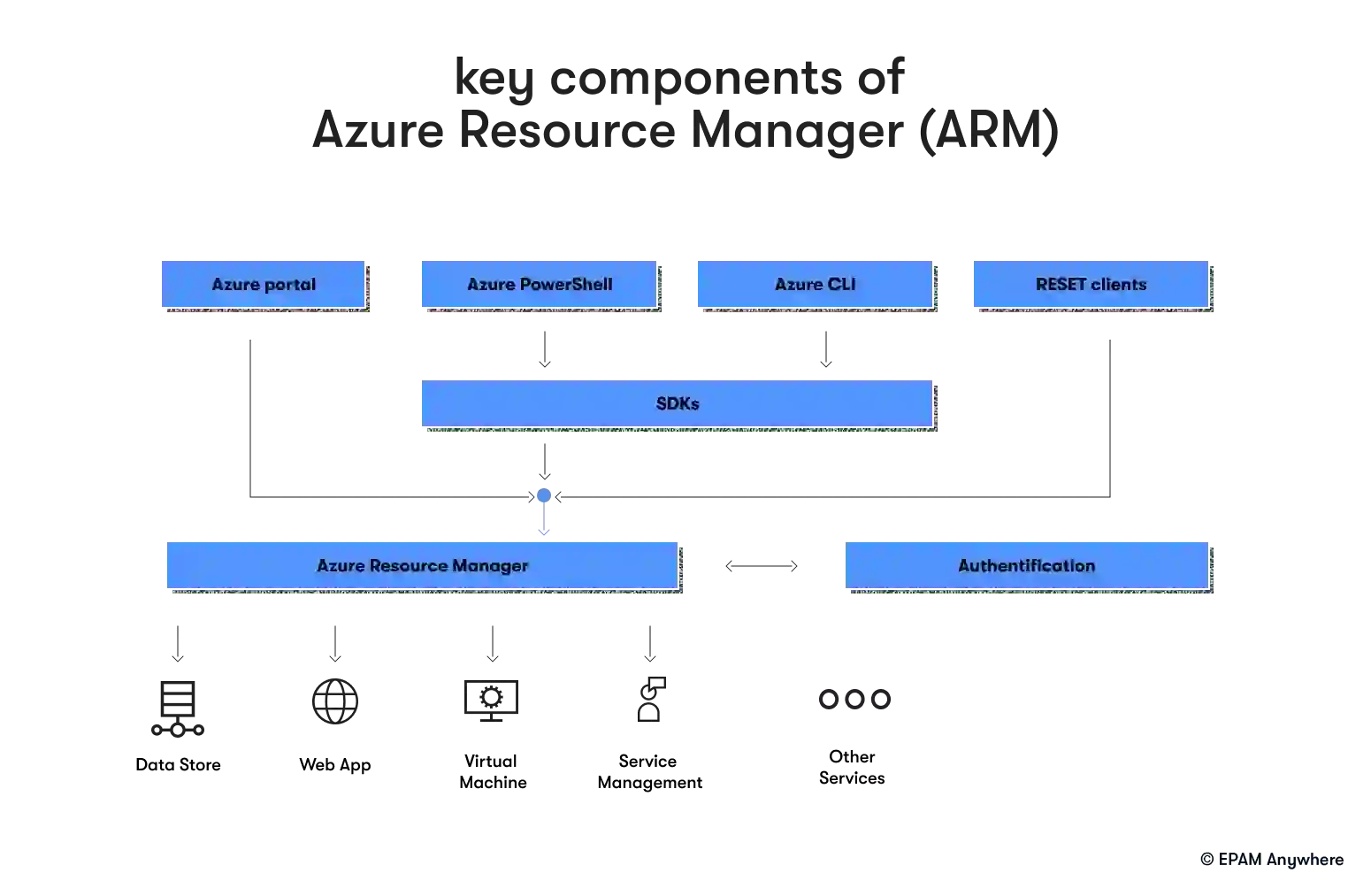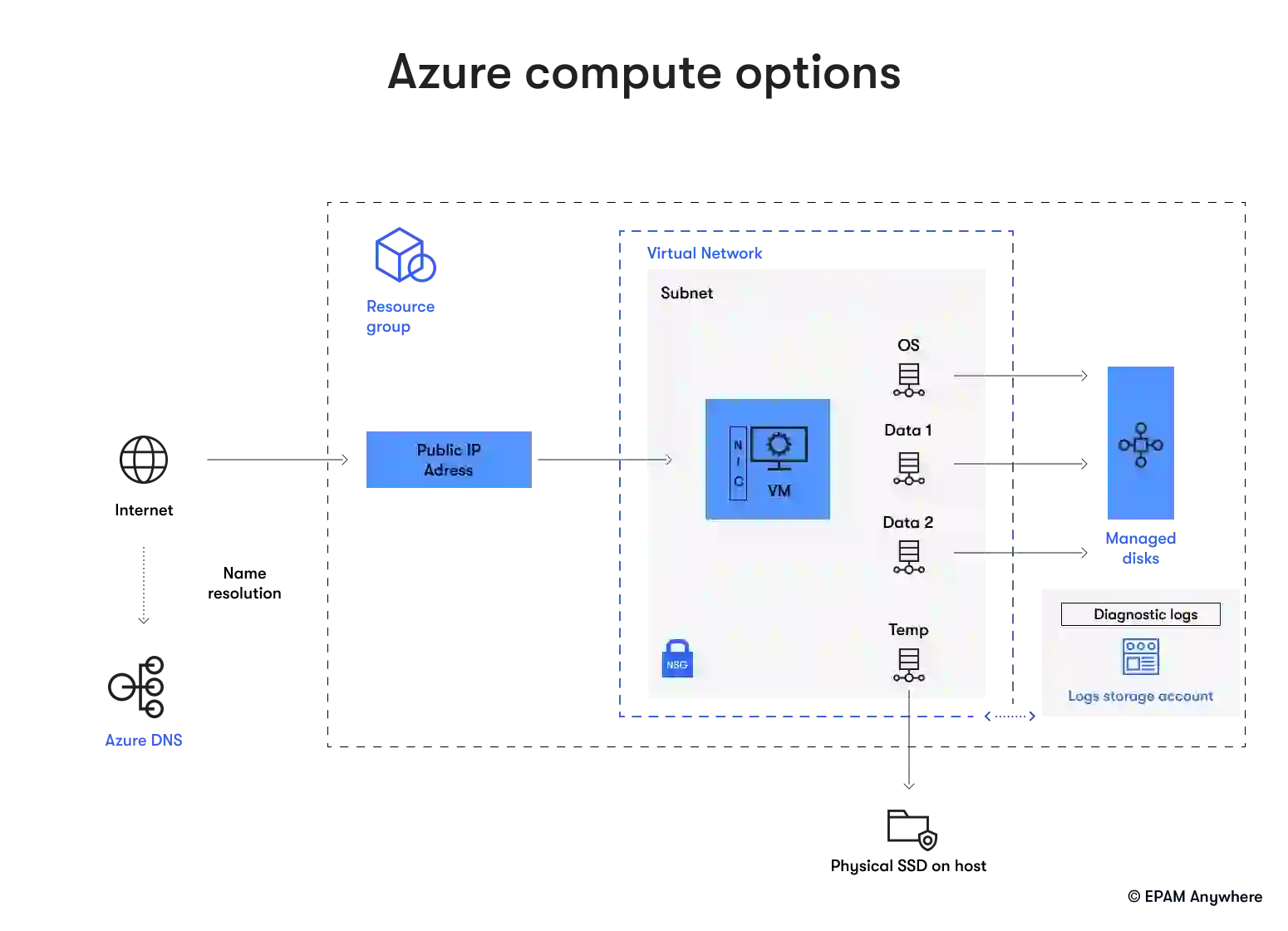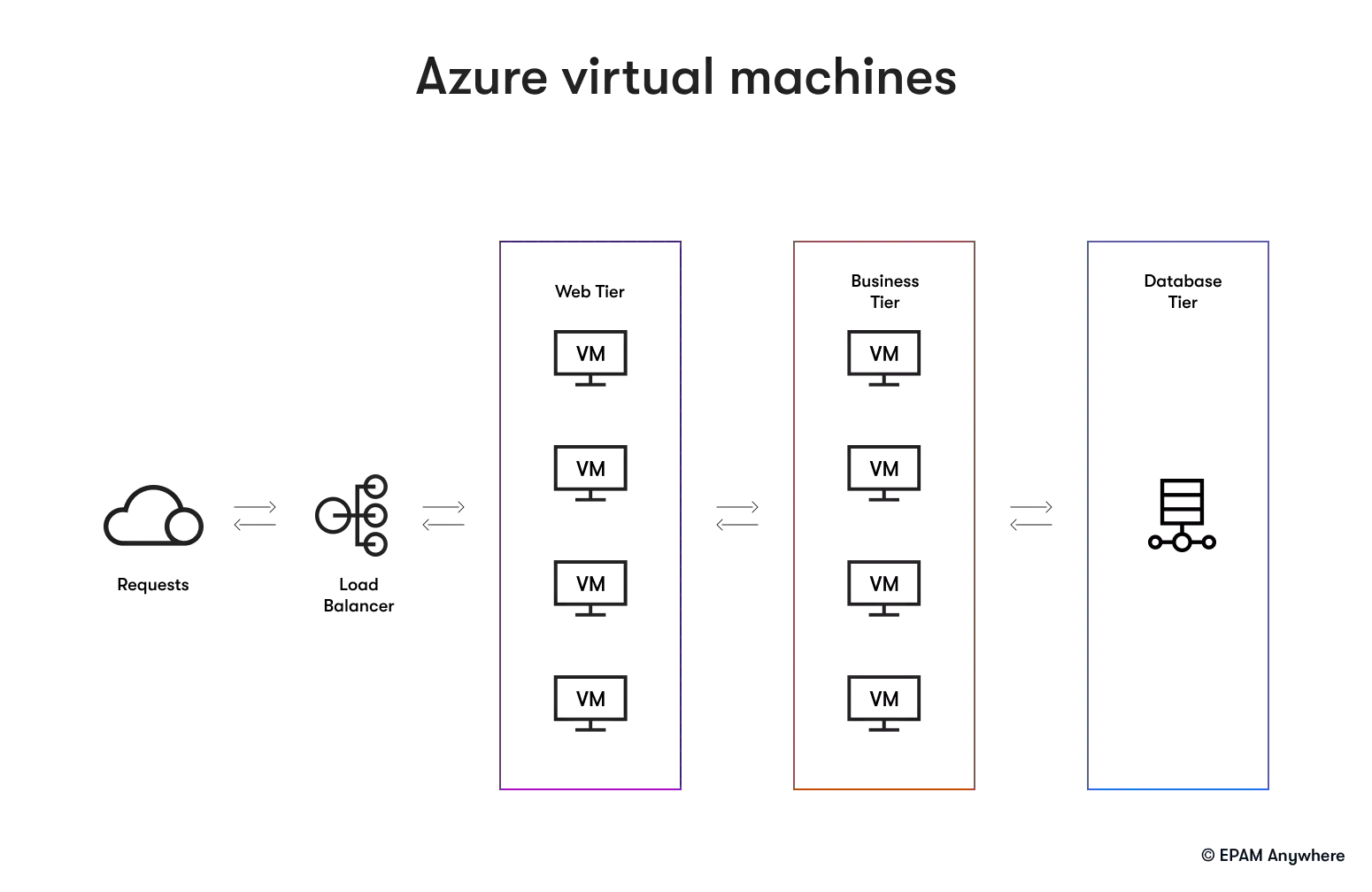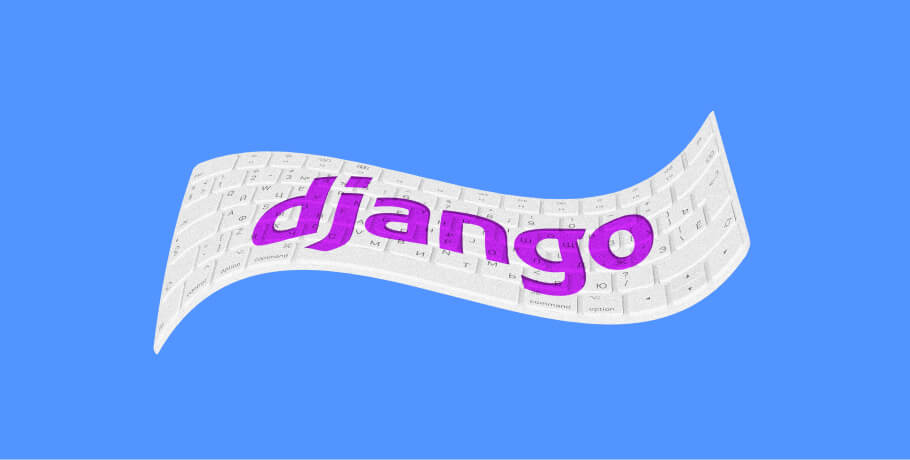This article has been reviewed and verified by Vadym Zagorodko, Senior Software Engineer and the Azure Discipline Co-head at EPAM Anywhere. Thank you, Vadym!
Preparing for an Azure interview can be a challenging task, as it requires a deep understanding of various Azure services, concepts, and best practices. To help you succeed in your upcoming interview, we have compiled a comprehensive list of Azure interview questions that cover essential topics such as Azure administration, development, migration, and security.
These senior Azure interview questions and answers delve into intricate topics and real-world scenarios, enabling you to demonstrate your in-depth knowledge and problem-solving abilities to potential employers. Reviewing these questions and their corresponding answers will enable you to showcase your expertise and land your dream Azure cloud engineer job.
searching for a remote job?
Look no further. Send your CV and we'll match your skills with the best remote Azure engineer job at EPAM Anywhere
1. What is Azure, and why is it important for developers?
Azure is a cloud computing platform and service provided by Microsoft. It offers a wide range of services, tools, and frameworks for developers to build, deploy, and manage applications. Azure is important for developers because it enables them to create scalable, reliable, and cost-effective applications without worrying about the underlying infrastructure.
2. Can you explain the difference between Azure Web Apps, Azure Functions, and Azure Logic Apps?
- Azure Web Apps is a platform-as-a-service (PaaS) offering for hosting web applications, REST APIs, and mobile app backends. They provide a fully managed environment with built-in support for various programming languages and frameworks.
- Azure Functions is a serverless computing service that allows developers to run small code (functions) in response to events or triggers without managing the underlying infrastructure.
- Azure Logic Apps is an Azure service for creating and running workflows that integrate with various services and data sources. They provide a visual designer to create workflows using pre-built connectors and actions.
3. What are the key components of the Azure Resource Manager (ARM)?
Azure Resource Manager (ARM) is an Azure resources deployment and management service. The key components of ARM include:
- Resource groups: A logical container for resources that are deployed within an Azure subscription.
- ARM templates: JSON files that define the resources, configurations, and dependencies for an Azure deployment.
- ARM API: A RESTful API for managing Azure resources programmatically.
- Role-based access control (RBAC): A mechanism for controlling access to Azure resources based on user roles and permissions.

4. How do you assess the readiness of an application for migration to Azure?
This is one of the common Azure migration interview questions. Assessing the readiness of an application for migration to Azure involves evaluating various factors to ensure a smooth transition and optimal performance in the cloud. Here are some key steps to follow:
- Compatibility analysis: Review the application's architecture, technology stack, and dependencies to ensure they are compatible with Azure services and platforms. Check for any deprecated or unsupported components that may need to be replaced or updated.
- Performance and scalability: Analyze the application's performance requirements, such as response times, throughput, and resource utilization. Determine if the application can benefit from Azure's auto-scaling, load balancing, and other performance optimization features.
- Data migration: Assess the data storage requirements, including the type and size of the data, and choose the appropriate Azure storage service, such as Azure SQL Database, Cosmos DB, or Blob Storage. Plan for data migration, including data transfer methods, data transformation, and data synchronization.
- Security and compliance: Review the application's security requirements, such as authentication, authorization, encryption, and data protection. Ensure that the chosen Azure services and configurations meet these requirements and comply with relevant industry regulations and standards.
- Networking and connectivity: Evaluate the application's networking requirements, including bandwidth, latency, and connectivity to on-premises or other cloud resources. Plan for the appropriate Azure networking services, such as Virtual Networks, ExpressRoute, or VPN Gateway.
- Cost estimation: Estimate the costs of running the application in Azure, considering factors such as compute, storage, networking, and data transfer. Use the Azure pricing calculator and consider cost optimization strategies, such as reserved instances, spot instances, or Azure Hybrid Benefit.
- Application modernization: Identify opportunities to modernize the application by leveraging Azure's PaaS and serverless offerings, such as Azure App Service, Azure Functions, or Azure Logic Apps. This can help improve the application's scalability, maintainability, and cost-efficiency.
- Migration strategy: Based on the assessment, choose the appropriate migration strategy, such as rehosting (lift-and-shift), refactoring (re-architecting), or rebuilding (re-platforming). Develop a detailed migration plan, including timelines, resources, and testing procedures.
By thoroughly assessing the application's readiness for migration to Azure, you can ensure a successful transition and maximize the benefits of the Azure cloud platform.
5. Can you explain the difference between Azure Service Bus, Event Hubs, and Event Grid?
Azure Service Bus is a fully managed enterprise integration message broker that supports both point-to-point and publish-subscribe communication patterns. It is designed for high-throughput, low-latency messaging scenarios.
Azure Event Hubs is a big data streaming platform and event ingestion service that can process millions of events per second. It is designed for real-time data processing and analytics.
Azure Event Grid is a fully managed event routing service that enables event-driven, reactive programming. It connects event sources with event handlers using a publish-subscribe model and supports filtering and routing based on event types and data.
6. What is Azure Active Directory (AAD), and how does it differ from an on-premises active directory?
Azure Active Directory (AAD), now Microsoft Entra ID, is a cloud-based identity and access management service that provides single sign-on (SSO), multi-factor authentication, and identity protection for applications and services.
AAD differs from an on-premises active directory in several ways:
- AAD is a cloud-based service, while an on-premises active directory is hosted on your infrastructure.
- AAD supports modern authentication protocols like OAuth 2.0 and OpenID Connect, while an on-premises active directory primarily uses Kerberos and NTLM.
- AAD provides built-in integration with other Azure services and third-party applications, while an on-premises active directory requires additional configuration and integration.
7. What are Azure Virtual Machines (VMs), and how do they differ from other computing options in Azure?
Azure Virtual Machines (VMs) are Infrastructure-as-a-Service (IaaS) offerings that provide on-demand, scalable compute resources in the cloud. VMs differ from other compute options in Azure, such as Web Apps and Functions, in that they provide more control over the underlying infrastructure, including the operating system, networking, and storage. This makes VMs suitable for workloads that require custom configurations or need to run specific software that is not supported by other Azure compute services.
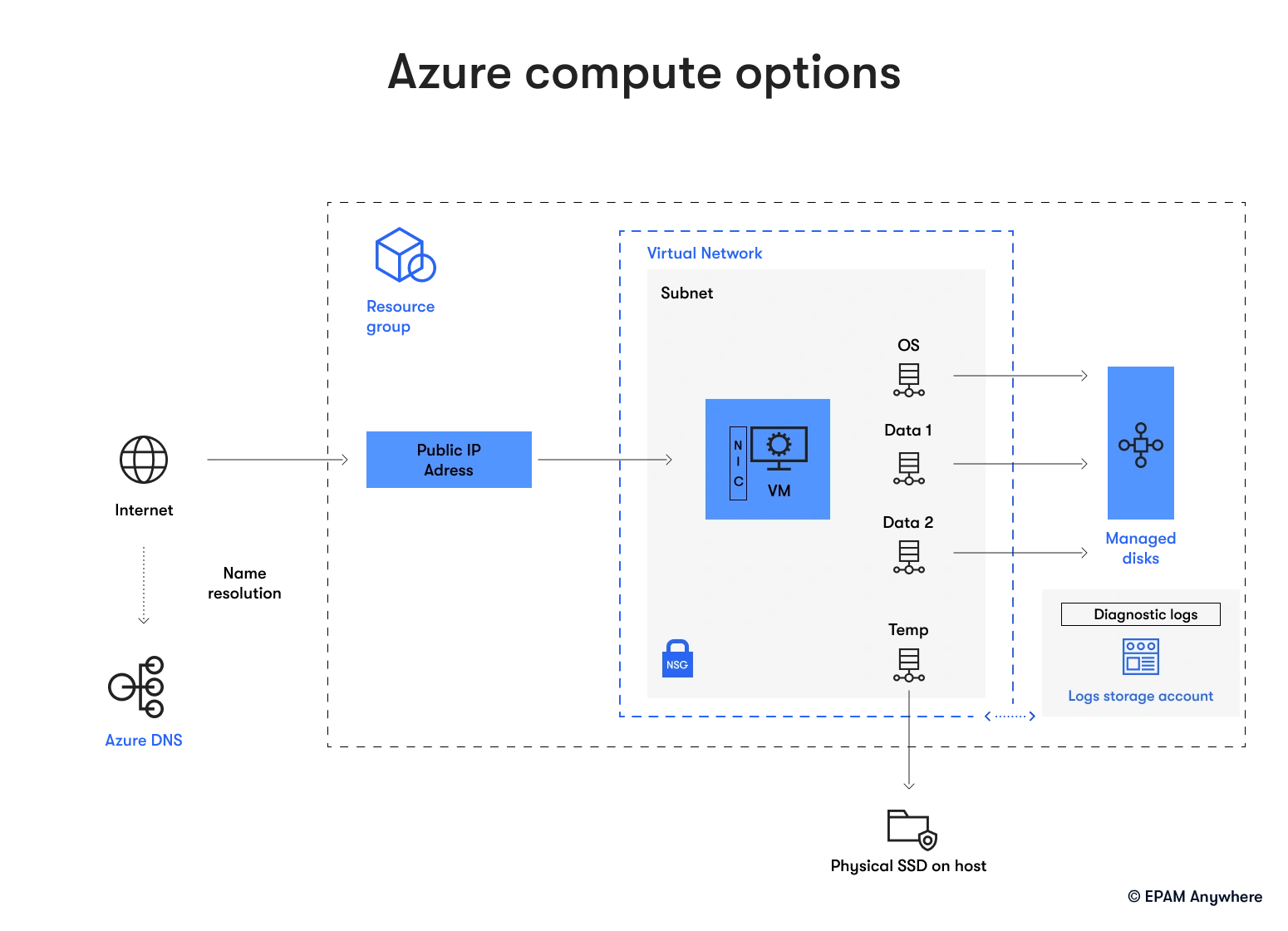
8. What is Azure Blob Storage, and what are its key features?
Azure Blob Storage is a scalable, cost-effective object storage service for unstructured data, such as text, images, videos, and binary files. Key features of Azure Blob Storage include:
- High availability and durability through data replication across multiple data centers.
- Support for hot, cool, and archive access tiers to optimize storage costs based on data access patterns.
- Integration with Azure Content Delivery Network (CDN) for global content distribution.
- Fine-grained access control and data encryption for security and compliance.
9. What is Azure DevOps, and how does it help developers?
Azure DevOps is a suite of services and tools for automating the software development lifecycle, including planning, coding, building, testing, deploying, and monitoring applications.
Azure DevOps helps developers by providing:
- A centralized platform for managing work items, source code, builds, releases, and test plans.
- Integration with popular development tools and frameworks, such as Visual Studio, Eclipse, and Jenkins.
- Built-in support for continuous integration (CI) and continuous deployment (CD) pipelines.
- Collaboration features for teams, such as Git repositories, pull requests, and Kanban boards.
10. What are the best practices for monitoring, logging, and alerting in Azure?
Best practices for monitoring, logging, and alerting in Azure are to:
- Use Azure Monitor: Leverage Azure Monitor to collect, analyze, and visualize performance metrics, logs, and custom events from Azure resources and applications.
- Enable diagnostic settings: Configure diagnostic settings for Azure resources to collect resource logs, metrics, and activity data.
- Utilize log analytics: Store and query log data in a Log Analytics workspace, create custom queries, and visualize data using Azure Dashboards.
- Implement application insights: Integrate Application Insights for application performance monitoring, exception tracking, and distributed tracing.
- Set up alerts: Create alerts and action groups based on specific metrics, log queries, or events, and configure notifications or automated actions.
- Monitor security: Use Azure Security Center (now called Microsoft Defender for Cloud) for continuous security monitoring, threat detection, and compliance assessment.
- Establish custom metrics and events: Track custom metrics and events relevant to your application using custom code or third-party tools.
- Regularly review and optimize: Periodically review monitoring data, identify trends, and optimize resource performance, cost, and reliability.
11. What is Azure Kubernetes Service (AKS), and what are its benefits?
Azure Kubernetes Service (AKS) is a managed container orchestration service based on the Kubernetes platform. AKS simplifies the deployment, scaling, and management of containerized applications by providing:
- A fully managed Kubernetes control plane, with automatic upgrades and patching.
- Integration with Azure services, such as Azure Active Directory, Azure Monitor, and Azure Policy.
- Support for advanced networking, storage, and security features.
- Tools and utilities for cluster management, such as the Kubernetes dashboard and the kubectl command-line interface.
12. What is Azure Cosmos DB, and what are its key features?
Azure Cosmos DB is a globally distributed, multi-model database service designed for low-latency, high-throughput, and scalable applications. Key features of Azure Cosmos DB include:
- Support for multiple data models, such as document, key-value, graph, and column-family.
- Global distribution with automatic data replication across multiple Azure regions.
- Tunable consistency levels for balancing data consistency and performance.
- Built-in support for partitioning, indexing, and querying data.
13. What is Azure Data Factory, and how does it help with data integration and transformation?
Azure Data Factory is a cloud-based data integration service that enables you to create, schedule, and manage data workflows for moving and transforming data from various sources to various destinations. Azure Data Factory helps with data integration and transformation by providing:
- A visual interface for designing and monitoring data pipelines.
- Support for a wide range of data sources and destinations, such as databases, file systems, and cloud storage services.
- Built-in data transformation activities, such as data movement, data flow, and data lake analytics.
- Integration with Azure Machine Learning and Azure Databricks for advanced data processing and analytics.
Azure security interview questions
14. How does Azure ensure data security and privacy?
Azure provides multiple layers of security, such as data encryption at rest and in transit, network isolation, and access control. Azure also complies with industry standards and regulations, such as GDPR, HIPAA, and PCI DSS.
15. What is Azure Private Link, and how does it improve network security?
Azure Private Link enables you to access Azure services over a private connection from your on-premises or virtual network. This improves network security by keeping traffic within the Azure backbone network and avoiding exposure to the public internet.
16. How can you monitor and audit Azure resources for security and compliance?
Azure provides various tools and services for monitoring and auditing resources, such as Azure Monitor, Azure Security Center, and Azure Policy. These tools help you detect and respond to security threats, enforce compliance policies, and generate audit reports for regulatory purposes.
17. What is the role and key responsibilities of an Azure administrator?
An Azure Administrator manages and maintains Azure cloud infrastructure, services, and resources. Their key responsibilities include:
- Provisioning, configuring, and monitoring Azure resources and services.
- Implementing and managing storage, compute, and networking components.
- Ensuring high availability, scalability, and performance of Azure infrastructure.
- Managing and monitoring security, identity, and access control.
- Troubleshooting and resolving issues related to Azure services and resources.
18. What are the key differences between Azure Resource Manager (ARM) templates and Azure PowerShell for managing Azure resources?
ARM templates are JSON files that define the resources, configurations, and dependencies for an Azure deployment. They provide a declarative way to manage Azure resources and enable Infrastructure as Code (IaC) practices. ARM templates are language-agnostic and can be used with various tools and platforms.
Azure PowerShell is a command-line interface for managing Azure resources using PowerShell scripts. It provides a procedural way to manage resources and is best suited for automation tasks and interactive management.
19. How do you ensure high availability and disaster recovery for Azure Virtual Machines (VMs)?
To ensure high availability for Azure VMs, you can:
- Deploy VMs in an Availability Set, which distributes VMs across multiple fault domains and update domains within a data center.
- Use Azure Virtual Machine Scale Sets to automatically scale the number of VM instances based on demand or a predefined schedule.
- Deploy VMs in multiple Azure regions and use Azure Traffic Manager or Azure Front Door to distribute traffic across regions.
For disaster recovery, you can:
- Use Azure Site Recovery to replicate VMs to a secondary Azure region and enable failover in case of a disaster.
- Regularly back up VMs using Azure Backup and restore them to a new VM in case of data loss or corruption.
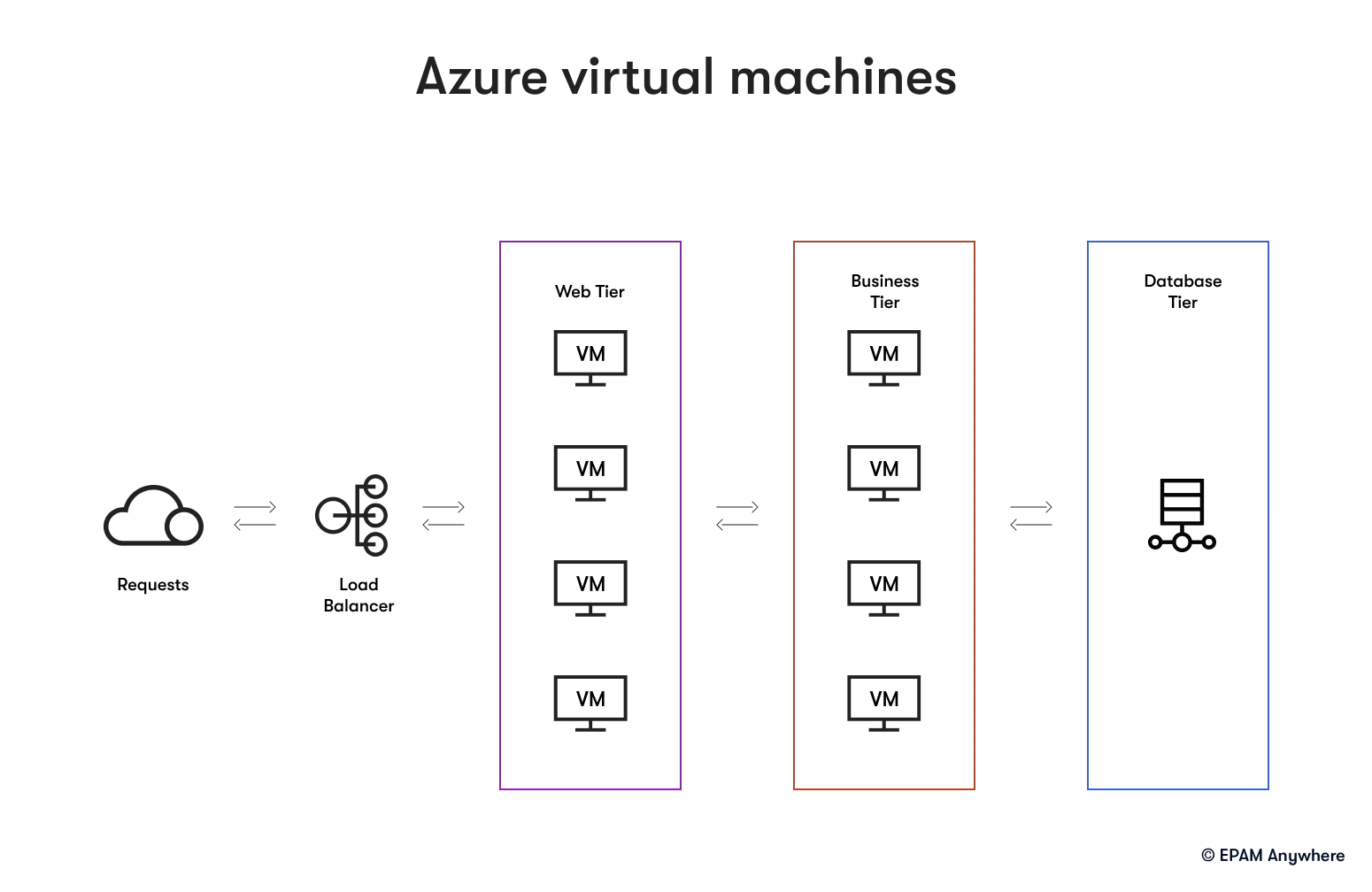
20. What is Azure Storage Service Encryption (SSE), and how does it help protect data?
Azure Storage Service Encryption (SSE) is a feature that automatically encrypts data at rest in Azure Blob Storage, File Storage, Table Storage, and Queue Storage. SSE uses Azure-managed encryption keys or customer-managed keys to encrypt data before it is written to storage and decrypts it when it is read. This helps protect data from unauthorized access and ensures compliance with data security and privacy regulations.
21. How do you monitor and optimize the performance of Azure resources?
To monitor and optimize the performance of Azure resources, you can:
- Use Azure Monitor to collect, analyze, and visualize performance metrics and logs from Azure resources.
- Set up alerts and notifications based on performance thresholds or specific events.
- Use Azure Advisor to get personalized recommendations for optimizing resource performance, cost, security, and reliability.
- Implement autoscaling for compute resources, such as VMs and App Services, to adjust capacity based on demand.
- Use Azure CDN and Azure Traffic Manager to optimize content delivery and network performance.
22. What are the key components of Azure Identity and Access Management (IAM), and how do they help secure Azure resources?
The key components of Azure IAM include:
- Azure Active Directory (AAD): A cloud-based identity and access management service that provides single sign-on, multi-factor authentication, and identity protection for applications and services.
- Role-Based Access Control (RBAC): A mechanism for controlling access to Azure resources based on user roles and permissions. RBAC enables you to grant the least privilege necessary for users to perform their tasks.
- Azure Privileged Identity Management (PIM): A service that helps manage, control, and monitor access to privileged accounts and resources in Azure. PIM provides features such as just-in-time access, approval workflows, and access reviews.
23. What is Azure policy, and how does it help enforce compliance and governance in Azure?
Azure Policy is a service that enables you to define, enforce, and audit policies for Azure resources. Policies are rules that govern the properties, configurations, and actions of resources to ensure compliance with organizational standards and regulatory requirements. Azure Policy helps enforce compliance and governance by:
- Automatically applying policies to resources during deployment and preventing non-compliant resources from being created.
- Continuously monitoring existing resources for compliance and reporting violations.
- Integrating with Azure DevOps and ARM templates to enable policy-driven infrastructure as code.
Azure networking interview questions
24. What is Azure Virtual Network (VNet), and what are its key features?
Azure Virtual Network (VNet) is a logically isolated network within the Azure cloud that enables you to connect Azure resources and on-premises networks securely. Key features of Azure VNet include:
- Private IP address space and DNS settings for resources within the VNet.
- Subnets for organizing and segmenting resources based on security and network requirements.
- Network Security Groups (NSGs) for controlling inbound and outbound traffic to resources.
- Virtual Network Gateway for connecting VNets to on-premises networks using VPN or ExpressRoute.
- VNet peering for connecting VNets within the same or different Azure regions.
25. What is Azure Network Security Group (NSG), and how does it help secure Azure resources?
Azure Network Security Group (NSG) is a virtual firewall that controls inbound and outbound network traffic to and from Azure resources, such as VMs and subnets. NSGs use security rules to define allowed or denied traffic based on source and destination IP addresses, ports, and protocols. By applying NSGs to resources, you can restrict network access and protect them from unauthorized access and attacks.

26. What is Azure Load Balancer, and how does it help distribute traffic to Azure resources?
Azure Load Balancer is a network service that distributes incoming network traffic across multiple resources, such as VMs, to ensure high availability, scalability, and low latency. Azure Load Balancer supports both Layer 4 (TCP/UDP) and Layer 7 (HTTP/HTTPS) traffic and provides features such as:
- Health probes for monitoring the availability and responsiveness of resources.
- Load balancing rules for distributing traffic based on source and destination IP addresses, ports, and protocols.
- Session persistence for maintaining client connections to the same resource during a session.
- Integration with Azure Availability Sets and Virtual Machine Scale Sets for distributing traffic across fault domains and update domains.
27. What is Azure ExpressRoute, and when should you use it?
Azure ExpressRoute is a dedicated, private network connection between your on-premises infrastructure and Azure data centers. ExpressRoute provides faster, more reliable, and more secure connectivity compared to a standard internet-based VPN connection. You should use ExpressRoute when:
- You require low-latency, high-bandwidth connectivity between your on-premises and Azure environments.
- You need to transfer large amounts of data between your on-premises and Azure environments.
- You have strict security and compliance requirements that mandate a private connection to Azure.
28. What is Azure Backup, and how does it help protect Azure resources?
Azure Backup is a cloud-based backup service that enables you to back up and restore Azure resources, such as VMs, databases, and file shares. Azure Backup helps protect Azure resources by:
- Providing a centralized, scalable, and cost-effective solution for backing up data and applications.
- Supporting incremental backups, which reduce storage and network costs by only backing up changed data.
- Encrypting backup data at rest and in transit for security and compliance.
- Offering flexible retention policies and recovery options to meet your business continuity and disaster recovery requirements.
29. What is Azure site recovery, and how does it help with disaster recovery in Azure?
Azure Site Recovery is a cloud-based disaster recovery service that enables you to replicate, failover, and recover Azure resources and on-premises workloads in case of a disaster or outage. Azure Site Recovery helps with disaster recovery in Azure by:
- Providing a simple, automated, and cost-effective solution for replicating and recovering resources across Azure regions or between on-premises and Azure environments.
- Supporting various replication technologies, such as Hyper-V Replica, Azure VM replication, and VMware vSphere replication.
- Offering customizable recovery plans, including failover, failback, and testing capabilities.
- Integrating with Azure Monitor and Azure Automation for monitoring and orchestrating disaster recovery processes.
30. What is Azure cost management, and how does it help control and optimize Azure spending?
Azure Cost Management is a suite of tools and services that help you monitor, analyze, and optimize your Azure spending. Azure Cost Management provides:
- Cost analysis reports and dashboards for visualizing and understanding your Azure spending patterns.
- Budgets and alerts for tracking and controlling spending against predefined limits.
- Cost recommendations based on your usage patterns and Azure best practices.
- Integration with Azure Policy for enforcing cost-related policies and compliance.
31. What are some best practices for securing Azure resources and data?
Some best practices for securing Azure resources and data include:
- Implementing the principle of least privilege by granting users and applications the minimum permissions necessary to perform their tasks.
- Using Azure Active Directory and Role-Based Access Control (RBAC) for managing access to resources and services.
- Encrypting data at rest and in transit using Azure Storage Service Encryption (SSE) and Azure Disk Encryption.
- Regularly monitoring and auditing resource activity using Azure Monitor, Azure Security Center, and Azure Policy.
- Implementing network security best practices, such as using Network Security Groups (NSGs), Azure Firewall, and Azure Private Link.
- Regularly backing up resources and implementing disaster recovery plans using Azure Backup and Azure Site Recovery.
8 scenario-based Azure interview questions
- Your company is planning to migrate an existing web application to Azure. The application consists of a front-end web server, a back-end database server, and a file storage system. Describe the Azure services and components you would recommend for each part of the application and explain your choices.
- You are tasked with designing a serverless architecture for a new image processing application in Azure. The application should automatically generate thumbnails for images uploaded to a storage account and store the thumbnails in a separate container. Explain how you would implement this solution using Azure Functions and other Azure services.
- A client wants to implement a multi-region disaster recovery strategy for their Azure-based e-commerce application. The application consists of a web front-end, a REST API, and an SQL database. Describe the steps you would take to ensure the application can failover to a secondary region in case of a regional outage.
- Your company has an Azure-based application that processes sensitive customer data. The security team has requested that all data stored in Azure must be encrypted both at rest and in transit. Explain how you would implement encryption for data stored in Azure Blob Storage and data transmitted between Azure services.
- You are responsible for optimizing the performance of an Azure-based web application that serves users from multiple geographic locations. The application consists of static content, dynamic content generated by a REST API, and a real-time chat feature. Describe the Azure services and strategies you would use to improve the application's performance for users in different regions.
- A client has an on-premises application that relies on Active Directory for authentication and authorization. They want to migrate the application to Azure and continue using their existing Active Directory infrastructure. Explain how you would integrate the on-premises Active Directory with Azure Active Directory and enable single sign-on for the migrated application.
- Your company is developing a new IoT solution that collects telemetry data from thousands of devices and processes the data in real-time. The processed data should be stored in a database for further analysis and reporting. Describe the Azure services and components you would use to build the data ingestion, processing, and storage pipeline for this solution.
- You are tasked with implementing a monitoring and alerting solution for an Azure-based application. The solution should collect performance metrics, logs, and custom events from the application and its underlying infrastructure. It should also trigger alerts and notifications based on predefined thresholds and conditions. Explain how you would use Azure Monitor and other Azure services to implement this solution.
Conclusion
In conclusion, mastering Azure interview questions is crucial for candidates seeking to excel in Azure-related roles. By familiarizing yourself with these questions and their corresponding answers, you will be better prepared to demonstrate your expertise and problem-solving abilities during interviews. The questions cover a wide range of topics, including Azure administration, development, migration, and security, ensuring that you have a comprehensive understanding of the Azure ecosystem.
As the demand for skilled Azure professionals continues to grow, remote Azure engineer jobs offer an excellent opportunity to advance your career while enjoying the flexibility and benefits of remote work. By joining EPAM Anywhere, you will have access to exciting projects, professional development opportunities, and a supportive community of like-minded professionals.
So, if you are confident in your Azure knowledge and ready to take on new challenges, consider applying for remote Azure engineer jobs at EPAM Anywhere. With your Azure interview preparation and the vast opportunities available at EPAM Anywhere, you will be well on your way to a successful and fulfilling career in the Azure domain.

With a focus on remote lifestyle and career development, Gayane shares practical insight and career advice that informs and empowers tech talent to thrive in the world of remote work.
With a focus on remote lifestyle and career development, Gayane shares practical insight and career advice that informs and empowers tech talent to thrive in the world of remote work.
Explore our Editorial Policy to learn more about our standards for content creation.
read more



